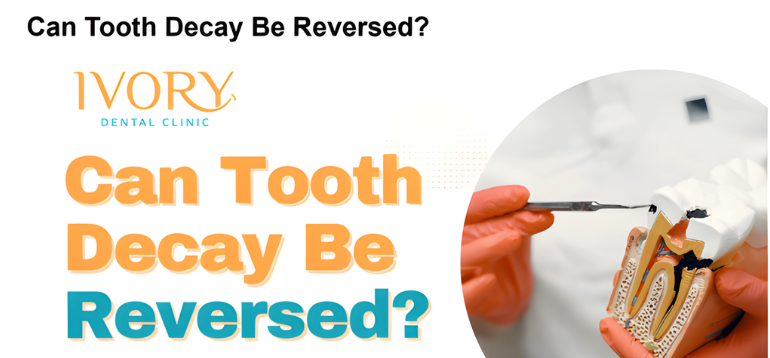Can Tooth Decay Be Reversed?
Tooth decay, also known as dental caries, is one of the most common dental issues. It happens when the enamel, the outer layer of the tooth, is damaged by acids produced by bacteria in your mouth. Many people wonder: can tooth decay be reversed, or is treatment always necessary?
How Tooth Decay Happens
Tooth decay begins when plaque, a sticky film of bacteria, builds up on your teeth. The bacteria feed on sugar and produce acids that weaken the enamel. If caught early, the decay may be stopped or even reversed.
Signs of Early Tooth Decay
- White spots on the teeth
- Sensitivity to hot, cold, or sweet foods
- Slight discomfort when chewing
If decay is detected early, your dentist can prevent it from worsening.
Can Tooth Decay Be Reversed?
Yes, but only in the very early stages. This is called enamel remineralization. It strengthens the weakened enamel before a cavity forms. Ways to help reverse early decay include:
- Fluoride Treatment: Fluoride strengthens enamel and can help repair minor damage.
- Good Oral Hygiene: Brushing twice a day, flossing daily, and using an antibacterial mouthwash.
- Diet Changes: Reduce sugar and acidic foods, and eat teeth-friendly foods like cheese, milk, and vegetables.
- Regular Dental Checkups: Early detection by a dentist is key to reversing decay.
When Decay Cannot Be Reversed
Once a cavity forms and the enamel is broken, decay cannot be reversed naturally. In this case, a dentist will remove the decayed portion and restore the tooth with fillings, crowns, or other treatments, depending on the severity of the damage.
Treatments at Ivory Dental Clinic
- Fillings to restore decayed teeth
- Crowns/Tooth Caps for severely damaged teeth (6,800–34,800 INR)
- Root Canal Treatment for decay reaching the pulp
- Preventive Care, like fluoride applications and dental sealants
Cost for Prevention and Care
| Treatment | Price (INR) |
|---|---|
| Fluoride Application | 1,200–2,000 |
| Tooth Cap/Crown | 6,800–34,800 |
| Fillings | 1,500–5,000 |
Conclusion
In short, tooth decay can often be stopped or reversed in its early stages with proper oral hygiene, a balanced diet, and professional care. Once a cavity forms, it cannot be reversed; however, modern dental treatments can effectively restore your teeth. Regular dental visits and preventive care are the best ways to maintain strong and healthy teeth.
Taking action early can save your teeth and prevent more serious problems, helping you maintain a healthy and confident smile.


